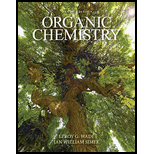
(a)
To draw: The resonance forms of three possible allylic intermediates that are formed during the reaction of NBS with
Interpretation: The resonance forms of three possible allylic intermediates that are formed during the reaction of NBS with
Concept introduction: The reaction that includes the addition of one or more bromine atoms in a compound is known as bromination reaction. Bromination reaction is a type of halogenation reaction. In this reaction, NBS (source of
A molecule that is uncharged and contains an unpaired electron is termed as free radical. Free radicals are highly reactive materials, but they have a short life span.
(b)
To determine: The ranking of three intermediates formed during the reaction of NBS with
Interpretation: The ranking of three intermediates formed during the reaction of NBS with
Concept introduction: The reaction that includes the addition of one or more bromine atoms in a compound is known as bromination reaction. Bromination reaction is a type of halogenation reaction. In this reaction, NBS (source of
A molecule that is uncharged and contains an unpaired electron is termed as free radical. Free radicals are highly reactive materials, but they have a short life span.
(c)
To draw: The products that are obtained from each of the free radical intermediate.
Interpretation: The products that are obtained from each of the free radical intermediate are to be drawn.
Concept introduction: The reaction that includes the addition of one or more bromine atoms in a compound is known as bromination reaction. Bromination reaction is a type of halogenation reaction. In this reaction NBS (source of
A molecule that is uncharged and contains an unpaired electron is termed as free radical. Free radicals are highly reactive materials, but they have short life span.
Want to see the full answer?
Check out a sample textbook solution
Chapter 6 Solutions
Organic Chemistry Plus Mastering Chemistry with Pearson eText -- Access Card Package (9th Edition) (New in Organic Chemistry)
- What is the product of the following reaction? Please explain what is happening in this question. Provide a detailed explanation and a drawing showing how the reagent is reacting with the catalysts to product the correct product. The correct answer is B.arrow_forwardWhat is the missing intermediate 1 and the final product 2. Please include a detailed explanation explaining the steps of malonic ester synthesis. Please include drawings of the intermediate and how it occurs and how the final product is former.arrow_forwardWhat would be the reagents and conditions above and below the arrow that will complete the proposed acetoacetic ester synthesis? If it cannot be done efficiently, then I will choose that answer. There could be 2 or 4 reagents involved. Please provide a detailed explanation and drawings showing how it would proceed with the correct reagents.arrow_forward
- For benzene, the ∆H° of vaporization is 30.72 kJ/mol and the ∆S° of vaporization is 86.97 J/mol・K. At 1.00 atm and 228.0 K, what is the ∆G° of vaporization for benzene, in kJ/mol?arrow_forwardThe reaction Q(g) + R(g) → Z(l) is shown to be exothermic. Which of the following is true concerning the reaction. it is spontaneous only at High T, it is spontaneous at low T it is nonspontaneous at all T it is spontanrous at all T. it is non spontaneous only at low T.arrow_forwardThe reaction Q(g) + R(g) → Z(l) is shown to be exothermic. Which of the following is true concerning the reactionarrow_forward
- Which of the following has the largest standard molar entropy, S° (298.15 K) He H2 NaCl KBr Hgarrow_forwardWhich of the following is true for a particular reaction if ∆G° is -40.0 kJ/mol at 290 K and –20.0 kJ/mol at 390 K?arrow_forwardWhat is the major product of the following reaction? O O OH OH 1. BH 2. H₂O₂, NaOH OH OHarrow_forward
 Organic Chemistry: A Guided InquiryChemistryISBN:9780618974122Author:Andrei StraumanisPublisher:Cengage Learning
Organic Chemistry: A Guided InquiryChemistryISBN:9780618974122Author:Andrei StraumanisPublisher:Cengage Learning
